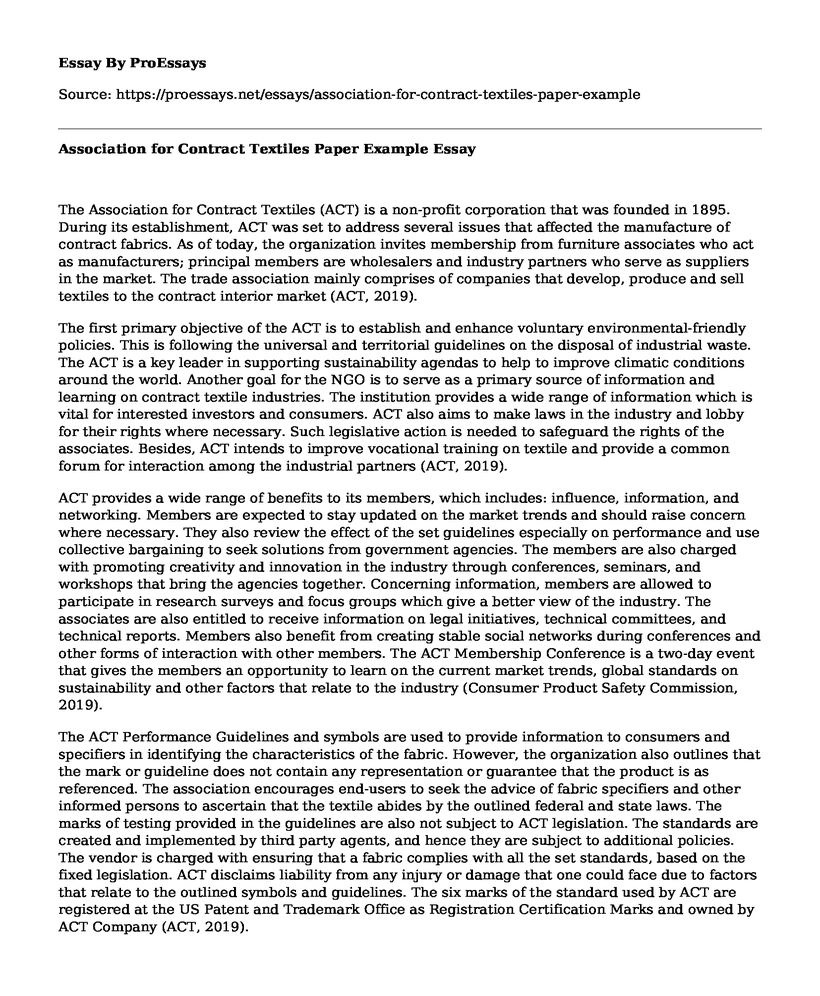The Association for Contract Textiles (ACT) is a non-profit corporation that was founded in 1895. During its establishment, ACT was set to address several issues that affected the manufacture of contract fabrics. As of today, the organization invites membership from furniture associates who act as manufacturers; principal members are wholesalers and industry partners who serve as suppliers in the market. The trade association mainly comprises of companies that develop, produce and sell textiles to the contract interior market (ACT, 2019).
The first primary objective of the ACT is to establish and enhance voluntary environmental-friendly policies. This is following the universal and territorial guidelines on the disposal of industrial waste. The ACT is a key leader in supporting sustainability agendas to help to improve climatic conditions around the world. Another goal for the NGO is to serve as a primary source of information and learning on contract textile industries. The institution provides a wide range of information which is vital for interested investors and consumers. ACT also aims to make laws in the industry and lobby for their rights where necessary. Such legislative action is needed to safeguard the rights of the associates. Besides, ACT intends to improve vocational training on textile and provide a common forum for interaction among the industrial partners (ACT, 2019).
ACT provides a wide range of benefits to its members, which includes: influence, information, and networking. Members are expected to stay updated on the market trends and should raise concern where necessary. They also review the effect of the set guidelines especially on performance and use collective bargaining to seek solutions from government agencies. The members are also charged with promoting creativity and innovation in the industry through conferences, seminars, and workshops that bring the agencies together. Concerning information, members are allowed to participate in research surveys and focus groups which give a better view of the industry. The associates are also entitled to receive information on legal initiatives, technical committees, and technical reports. Members also benefit from creating stable social networks during conferences and other forms of interaction with other members. The ACT Membership Conference is a two-day event that gives the members an opportunity to learn on the current market trends, global standards on sustainability and other factors that relate to the industry (Consumer Product Safety Commission, 2019).
The ACT Performance Guidelines and symbols are used to provide information to consumers and specifiers in identifying the characteristics of the fabric. However, the organization also outlines that the mark or guideline does not contain any representation or guarantee that the product is as referenced. The association encourages end-users to seek the advice of fabric specifiers and other informed persons to ascertain that the textile abides by the outlined federal and state laws. The marks of testing provided in the guidelines are also not subject to ACT legislation. The standards are created and implemented by third party agents, and hence they are subject to additional policies. The vendor is charged with ensuring that a fabric complies with all the set standards, based on the fixed legislation. ACT disclaims liability from any injury or damage that one could face due to factors that relate to the outlined symbols and guidelines. The six marks of the standard used by ACT are registered at the US Patent and Trademark Office as Registration Certification Marks and owned by ACT Company (ACT, 2019).
The Voluntary Performance guidelines were created to simplify the process of fabric specification in industries. These principles focus on fabric flammability and four other textile characteristics- colorfastness to light, physical properties, abrasion and wet and dry crocking. These regulations help in the classification of both woven and coated fabrics for indoor use. Woven textiles are formed through interlacing many sets of yarns while the coated ones are created by adding one or more layers of a film-forming polymer such as vinyl on the surface of a cloth (Consumer Product Safety Commission, 2019). These successful tests are regulated and reviewed by the American Society for Testing and Materials (ASTM) and the American Association of Textile Chemists and Colorist (AATCC). The colorfastness to light provides a measure of the fabric's resistance to fading when exposed to light.
The flammability condition in fabric classification evaluates a cloth when it is subjected to certain levels of ignition. The California Technical Bulletin 117-2013 Section 1 is a test method created by the State of California. The flammability test uses small cushions to evaluate the smolder resistance of furniture.
References
https://contracttextiles.org/about/https://www.cpsc.gov/Regulations-Laws--Standards/Statutes/Flammable-Fabrics-Act
Cite this page
Association for Contract Textiles Paper Example. (2022, Nov 07). Retrieved from https://proessays.net/essays/association-for-contract-textiles-paper-example
If you are the original author of this essay and no longer wish to have it published on the ProEssays website, please click below to request its removal:
- What Is the Phone? Essay Example
- Analyzing Mixed and Visual Rhetoric for Commercial
- Summary of Continuing Professional Development: Paper Example
- Customer Satisfaction in Tourism Industry Paper Example
- Essay Sample on Nokias Change Issues
- Essay Sample on Dolce & Gabbana Ad Provokes Public Outrage in China
- Paper Example on Johnson & Johnson: Medical Devices, Baby Products & More







